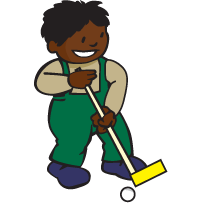Boston Children's Museum
308 Congress Street, Boston, MA 02210
617-426-6500
© Boston Children’s Museum 2025
Website Design by JackrabbitDesign engineering is a great way to teach kids problem solving, teamwork, materials and tool use, and the design process in general. In this activity, your students will also investigate angles, trial and error, and will use their math skills as they keep score of their golf round.
The putters for this activity are made out of dowels and pieces of foam. The foam should be made of lightweight, stiff, thick, cut-able material. Ask parents for any packing foam they may have, check with local companies that may unpack boxes with foam in them and may donate the foam to you. You can also order foam online – polyethylene, 2″ thick closed cell foam works best. This foam is sold in sheets, which you can cut up. A 12″ X 12″ sheet will yield twelve 2″ X 6″ or eighteen 2″ X 4″ putter heads, which is likely enough for your class. If you can’t find foam, putters can be made by taping a piece of cardboard to the dowel, though this doesn’t work as well as the foam. See Suggestions (in the “Make it Better” step) for online part numbers to order this foam.
Cut the foam into rectangles 4–6 inches long and 2 inches high and wide—you’ll need one for each student, plus a few extras if any putters break. Create a putter for yourself ahead of time by piercing a dowel into a piece of foam, or gluing it or taping it to the foam.
If you have the time, make a mini golf hole with the available materials and test it out. The “hole” refers not only to the cup at the end, but to the entire playable part—including the tee box (where you start playing from on each hole), the fairway (the part in between the start and the end of each hole) and the cup (the end of each hole—where you need to hit the ball into in order to complete playing the hole).

Ask your students if they have ever played golf or mini golf before. What equipment did they use? How do you keep score in mini golf? What does “par” mean? You can also show them the mini golf hole that you created (if you haven’t made a hole, have a volunteer draw a sample mini golf hole on the chalkboard or on a piece of chart paper). Ask them to point out in which direction they might hit the ball in order to make a hole-in-one. Is there more than one way to do it? Is it impossible?
Make your own mini golf hole and play on the golf holes that your classmates create!
After 15–20 minutes, bring your students together to talk about what they’ve done so far. Remind them that you don’t expect them to be finished, but that you want to talk about how it is going. Have each team share their process. Ask them how they got started, what challenges they are facing, something that they started out not sure about, but then figured out how to do, etc. In particular, ask them how they are going to create the “cup” – the end goal of each golf hole. Have the teams share ideas for how they might do this. This early discussion should last no more than 5-10 minutes – it is simply a check in, and a way to share early ideas.
Send your students back to work more on their golf holes. As they are building and designing, give your students some things to think about, such as:
Once each team has completed their mini golf holes, assign a hole number to each, so that the playing of the course can happen in an orderly manner. You might have a discussion before the playing starts, in which each team has a chance to show off the unique features of their mini golf hole.
After the children have played the entire course, have a wrap-up discussion. Have them talk about how easy or hard it was to hit the ball into the cup on some of the golf holes, how the ball reacted when it was struck against components of a hole made from different materials (does it bounce the same off of foam as it does off of wood?). Make a list of rules for their golf course, and for playing golf in general (ex. the harder you hit the ball, the farther it goes; bumpers around the edge of a mini golf hole help keep the ball from rolling away; you have to hit the ball harder to make it go uphill; etc.).